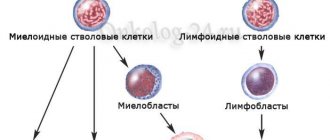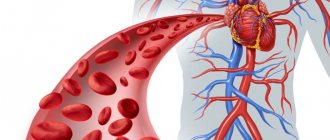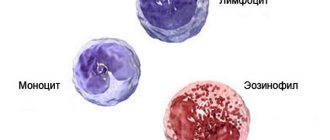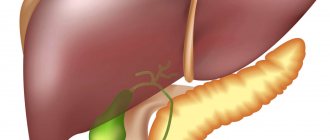Acute lymphoblastic leukemia is a pathological malignant neoplasm of the hematopoietic system. The disease originates in the bone marrow, where leukocytes (immature white blood cells) are produced in large quantities. Acute lymphoblastic leukemia absolutely controls the processes of growth, uniform renewal, and the complex maturation of all human cells is lost. Leukocytes do not mature and do not become full-fledged and functional cells, however, they rapidly and uncontrollably divide. Thus, there is a process of displacement of healthy cells by malignant ones in order to take their position in the bone marrow. Therefore, it loses the ability to form healthy platelets, red blood cells and white blood cells. This causes anemia, infectious complications and frequent bleeding. Sometimes these symptoms are the first signs of acute lymphoblastic leukemia.
All leukemias spread throughout the body through the blood and lymphatic system and affect almost all systems. Therefore, such an anomaly is considered a systemic malignant pathology and without timely, appropriate treatment, death can occur within a few months from the onset of the disease.
Acute lymphoblastic leukemia causes
In the development of this disease in humans, disturbances in the composition and structural set of chromosomes are assumed, which can be caused under the influence of hereditary or acquired factors as a result of peculiar mutations in genes. The main factors include ionizing radiation, and chemical mutagens play an important role in the formation of acute lymphoblastic leukemia.
There is evidence that this pathological neoplasm is becoming more frequent among individuals who have been exposed to benzene or who have taken cytotoxic drugs such as Mustargen, Leucaran, Imuran, Sarcolysin and Cyclophosphamide.
There are also suggestions that a hereditary factor predisposes the development of this pathology in the lymphatic tissue. In addition, there are descriptions of observations that relate to dominant and recessive modes of inheritance of acute lymphoblastic leukemia with low incidence in certain ethnic groups and high in others. Basically, in such cases, it is not the disease itself that is inherited, but the ability of chromosomes to undergo variability, i.e. lymph cells can transform into leukemia. Therefore, during chromosomal analysis it was found that acute lymphoblastic leukemia is characterized by the dispersal of a clone of pathological cells throughout the body, which were formed from the first cell that underwent mutation.
Acute lymphoblastic leukemia symptoms
This cancer is characterized by several stages of its progression. These include: the pre-leukemic period, followed by an acute form, then remission occurs, after which relapses of the disease are observed and the last stage is terminal. Of course, the last three stages of acute lymphoblastic leukemia in most cases depend on the effectiveness of the treatment. And if this disease is cured, then relapse processes and the terminal stage are absolutely absent. And with primary resistance, alternating remission and relapse are observed.
During the pre-leukemic period, clinical signs of acute lymphoblastic leukemia are almost impossible to diagnose. But the acute period begins quite quickly and is characterized by a variety of symptoms, which are characterized by processes of a strong increase in pathological tissue and suppression of the normal function of hematopoiesis. This is manifested by blastic transformation of the bone marrow, enlargement of somatic organs and lymph nodes.
In adults, various forms of acute lymphoblastic leukemia are characterized by early intoxication symptoms, anorexia without significant weight loss, and pain in the joints and bones. Further, there is an increase in organs such as the liver, spleen and lymph nodes, especially in the neck, armpits and groin. With enlarged submandibular, parotid and periorbital lymph nodes, a symptomatic Mikulicz complex is noted. During the course of the disease, many patients experience pallor of the mucous membranes and skin.
Also, acute lymphoblastic leukemia can manifest itself as a hemorrhagic syndrome, which is expressed by hemorrhages of a polymorphic nature from small to large, as well as nosebleeds, kidney and gastrointestinal tract bleeding. All these signs indicate the development of thrombocytopenia and anemia due to suppression of normal hematopoiesis.
Acute lymphoblastic leukemia is characterized by rare symptoms, such as leukemids, which form on the surface of the skin and in its fatty tissue. Necrotic changes in the skin, mucous membranes of the oral cavity and intestines may also be present.
As the pathological process progresses, acute lymphoblastic leukemia spreads to many organs. These include the central nervous system, lungs, visual organs, as well as reproductive organs. Such clinical symptoms are more typical for relapses of a malignant disease. But when acute lymphoblastic leukemia is characterized by the appearance of these signs at the beginning of the disease, this indicates a poor prognosis of the pathology.
Signs, symptoms and manifestations
The clinical picture of this disease is very ambiguous; in the early stages, symptoms can be mistaken for manifestations of another pathology.
The main features are presented:
- feverish reaction;
- chills;
- lack of appetite;
- loss of body weight;
- weakness, lethargy, dizziness;
- hemorrhagic manifestations - spontaneous bruises, petechiae, hemorrhages;
- frequent infectious diseases;
- pale skin;
- joint pain;
- vomiting (often mixed with blood);
- an increase in the size of the liver and spleen, pain on palpation.
Due to damage to the musculoskeletal system, pathological fractures often occur.
When carrying out diagnostic procedures, you can identify:
- in a general blood test: decreased levels of platelets, red blood cells and hemoglobin, increased leukocytes and ESR;
- in the myelogram: blast cells.
To assess the functioning of other organs and systems, a biochemical blood test should be performed, an electrocardiogram taken, an ultrasound examination of the abdominal organs, and a plain X-ray of the chest organs.
Acute lymphoblastic leukemia in children
This malignant neoplasm is considered the most common form of leukemia among adolescents and children, detected in almost 80% of all cases. According to statistics, almost 500 adolescents and children from birth to fourteen years old fall ill with this pathology every year.
Acute lymphoblastic leukemia can affect both children of any age and adults. Although this disease is diagnosed much more often among boys from one to five years of age than girls.
In children, acute lymphoblastic leukemia is caused by malignant mutations of lymphocytes, as a result of which new cells stop developing. This stopping process can occur at any stage of cell formation, so acute lymphoblastic leukemia can manifest itself in different forms. They all have a different clinical course of the disease, and treatment tactics will also depend on these forms.
At the moment, there are no exact reasons that would contribute to or influence the development of acute lymphoblastic leukemia in children. It is only known that the disease begins to develop when the precursors of lymphocytes change malignantly. Such mutations change the entire hereditary material of the cell. But basically it remains unclear why in some children these changes in genes lead to the formation of pathology, while in other children they do not. This can also be explained by the fact that acute lymphoblastic leukemia is influenced not only by genetic predisposition, but also by external factors. Thus, this disease is considered multifactorial.
It is also known that diseases such as Fanconi anemia and Down syndrome increase the risk of developing this malignant pathology in children. In addition, X-rays, radiation, chemical carcinogens, medications, and certain viruses may contribute to the development of acute lymphoblastic leukemia in children.
Within a few weeks, the first clinical picture of the disease develops. Since tumor pathological cells gradually affect the entire bone marrow and other organs, the symptoms of acute lymphoblastic leukemia in children initially manifest themselves as lethargy, lack of interest in games and pallor. This is explained by the insufficient number of red blood cells in the child’s body, which deliver oxygen to all cells. A deficiency of full-fledged lymphocytes and granulocytes weakens the immune system, which is a consequence of the development of frequent infections with febrile temperature.
If platelets are missing, skin hemorrhages and bleeding of mucous membranes occur. Malignant cells, moving throughout the body, cause not only changes in the blood, but also pain in various organs. First of all, pain appears in the bones of the arms and legs, after the bone marrow and bone cavities are filled with leukemia cells. Sometimes these pains become so severe that children are not even able to walk. When pathological cells accumulate in the lymph nodes, liver and spleen, pain appears in the abdominal area. And when the disease spreads to the membranes of the brain, children complain of headaches, they have paralysis of the facial nerve, vision is impaired and they may vomit.
The symptoms of acute lymphoblastic leukemia in different children can occur and manifest themselves individually. Therefore, to clarify the diagnosis, it is necessary to undergo a complete diagnosis of the disease.
If this anomaly is suspected, the pediatrician prescribes laboratory tests in the form of a detailed blood test. And already changes in the hemogram force a bone marrow puncture in the hospital to finally confirm the diagnosis. To obtain more accurate information about the affected organs, ultrasound, X-ray, MRI, CT and skeletal scintigraphy, and lumbar puncture are prescribed.
Acute lymphoblastic leukemia treatment
Once the diagnosis is confirmed, patients in a specialized clinic begin to receive the most modern and effective treatment. In the treatment of acute lymphoblastic leukemia, polychemotherapy is given priority. To do this, patients are prescribed cytostatic drugs that slow down and reduce the growth of cancer cells. Some patients additionally receive radiation to the central nervous system. And the use of high-dose chemotherapy makes it possible to perform stem cell transplantation. The main goal in this treatment of acute lymphoblastic leukemia is to be able to completely destroy malignant leukemia cells throughout the body in order to restore full function of the bone marrow.
The duration and intensity of polychemotherapy, the need for radiation irradiation of the nervous system, transplantation, as well as the outcome of treatment and prognosis will largely depend on the type of acute lymphoblastic leukemia, its spread throughout the patient’s body and how the disease is treatable.
Simultaneously with chemotherapy, accompanying therapy for acute lymphoblastic leukemia is prescribed, which is aimed at combating various infections, while eliminating side effects after polychemotherapy and symptoms of intoxication. For severe thrombocytopenia and anemia, blood substitute transfusions are prescribed.
Bone marrow cell transplantation is one of the treatment methods for a disease such as acute lymphoblastic leukemia. It is used for those patients who have complications due to the presence of the Philadelphia chromosome. An important point in the treatment process remains the prevention of infection, due to the weakening of the immune system in patients. Acute lymphoblastic leukemia is less treatable in adults, in contrast to childhood pathology.
Diagnostics
It is important to begin treatment of the disease in a timely manner; this is the only way to improve the future prognosis. To identify acute lymphocytic leukemia, several diagnostic measures are used, which are discussed in the table:
| Name of diagnostic test | Description |
| General blood analysis | The first and quickest study to suspect disorders in the body. The pathology is characterized by an increased level of leukocytes, a decrease in erythrocytes and platelets, and an increase in ESR. |
| Bone marrow puncture | The main changes occur in the bone marrow, so puncture is a necessary diagnostic measure. Allows you to examine abnormalities in chromosomes, as well as determine the type of blast cells. |
| CT, MRI and radiography | Helps identify the structure and enlargement of lymph nodes. |
| Ultrasound | It is carried out to monitor the condition of the spleen. |
| Lumbar puncture | For diagnosis, cerebrospinal fluid is used to detect leukemia cells. |
To make an accurate diagnosis, a complete examination using all of the above methods is necessary. If you notice the first symptoms of the disease, you must immediately contact a medical facility.
Acute lymphoblastic leukemia prognosis
Today, about 70% of children who suffer from acute lymphoblastic leukemia have a five-year remission, but in adults the duration of the remission period can only be achieved in 20%. For example, in Germany, out of 600 patients who first fell ill with this pathology, 90 have recurrent disease processes, i.e. almost every seventh. Basically, the return of the disease occurs in the first two years after diagnosis of the pathology and in rare cases – after five years.
As a rule, the chances of recovery after acute lymphoblastic leukemia returns are very small, although in some patients repeated therapy gives good results. The five-year survival rate for recurrent manifestations of the disease is about 35%.
Statistical indicators cannot predict the prognosis of malignant pathology. Acute lymphoblastic leukemia can both proceed and end completely unpredictably, even with the most favorable course or vice versa.
The information presented in this article is intended for informational purposes only and cannot replace professional advice and qualified medical care. If you have the slightest suspicion that you have this disease, be sure to consult your doctor!
Forecast
After therapy, the patient must be observed by a doctor for three months. Further prognosis for recovery is determined based on disease activity.
If lymphocytic leukemia is aggressive and accompanied by increasing symptoms, death occurs within two years. An improvement in general condition is noted in 70% of cases.
But achieving a complete cure is difficult. Even after treatment, the average life expectancy is about ten years.











